Experimental Study on the Localized Deformation and Damage Behavior of Polymer-Bonded Explosive Simulant under Cyclic Compression
Abstract
1. Introduction
2. Materials and Methods
2.1. Materials and Specimen
2.2. Cyclic Compression and CT Scanning Experiments
3. The Augmented Lagrangian Digital Volume Correlation Methodology
4. Results and Discussion
4.1. Macroscopic Mechanical Behaviors and Mesoscale Failure Mechanisms
4.2. Three-Dimensional Deformation and Damage
5. Conclusions
Author Contributions
Funding
Institutional Review Board Statement
Informed Consent Statement
Data Availability Statement
Conflicts of Interest
References
- Plassart, G.; Picart, D.; Gratton, M.; Frachon, A.; Caliez, M. Quasistatic Mechanical Behavior of HMX- and TATB-Based Plastic-Bonded Explosives. Mech. Mater. 2020, 150, 103561. [Google Scholar] [CrossRef]
- Field, J.E. Hot Spot Ignition Mechanisms for Explosives. Acc. Chem. Res. 1992, 25, 489–496. [Google Scholar] [CrossRef]
- Berghout, H.L.; Son, S.F.; Hill, L.G.; Asay, B.W. Flame Spread through Cracks of PBX 9501 (a Composite Octahydro-1,3,5,7-Tetranitro-1,3,5,7-Tetrazocine-Based Explosive). J. Appl. Phys. 2006, 99, 114901. [Google Scholar] [CrossRef]
- Drodge, D.R.; Williamson, D.M. Understanding Damage in Polymer-Bonded Explosive Composites. J. Mater. Sci. 2016, 51, 668–679. [Google Scholar] [CrossRef]
- Duarte, C.A.; Kohler, R.; Koslowski, M. Dynamic Fracture and Frictional Heating Due to Periodic Excitation in Energetic Materials. J. Appl. Phys. 2018, 124, 165109. [Google Scholar] [CrossRef]
- Palmer, S.J.P.; Field, J.E.; Huntley, J.M. Deformation, Strengths and Strains to Failure of Polymer Bonded Explosives. Proc. R. Soc. Lond. Ser. A Math. Phys. Sci. 1997, 440, 399–419. [Google Scholar] [CrossRef]
- Rae, P.J.; Goldrein, H.T.; Palmer, S.J.P.; Field, J.E.; Lewis, A.L. Quasi–Static Studies of the Deformation and Failure of β–HMX Based Polymer Bonded Explosives. Proc. R. Soc. Lond. Ser. A Math. Phys. Eng. Sci. 2002, 458, 743–762. [Google Scholar] [CrossRef]
- Williamson, D.M.; Palmer, S.J.P.; Proud, W.G.; Govier, R. Brazilian Disc Testing of a UK PBX above and below the Glass Transition Temperature. AIP Conf. Proc. 2007, 955, 803–806. [Google Scholar] [CrossRef]
- Chen, P.; Huang, F.; Ding, Y. Microstructure, Deformation and Failure of Polymer Bonded Explosives. J. Mater. Sci. 2007, 42, 5272–5280. [Google Scholar] [CrossRef]
- Wang, X.; Ma, S.; Zhao, Y.; Zhou, Z.; Chen, P. Observation of Damage Evolution in Polymer Bonded Explosives Using Acoustic Emission and Digital Image Correlation. Polym. Test. 2011, 30, 861–866. [Google Scholar] [CrossRef]
- Walters, D.J.; Luscher, D.J.; Yeager, J.D.; Patterson, B.M. Cohesive Finite Element Modeling of the Delamination of HTPB Binder and HMX Crystals under Tensile Loading. Int. J. Mech. Sci. 2018, 140, 151–162. [Google Scholar] [CrossRef]
- Kerschen, N.E.; Drake, J.D.; Sorensen, C.J.; Guo, Z.; Mares, J.O.; Fezzaa, K.; Sun, T.; Son, S.F.; Chen, W.W. X-ray Phase Contrast Imaging of the Impact of Multiple HMX Particles in a Polymeric Matrix. Propellants Explos. Pyrotech. 2020, 45, 607–614. [Google Scholar] [CrossRef]
- Quansah, J.D.; Zhang, X.; Wasiullah, Q.; Yan, Q. Mechanical and Thermophysical Properties of Energetic Crystals: Evaluation Methods and Recent Achievements. FirePhysChem 2023, 3, 234–254. [Google Scholar] [CrossRef]
- Yuan, Z.-N.; Chen, H.; Li, J.-M.; Dai, B.; Zhang, W.-B. In-Situ X-Ray Tomography Observation of Structure Evolution in 1,3,5-Triamino-2,4,6-Trinitrobenzene Based Polymer Bonded Explosive (TATB-PBX) under Thermo-Mechanical Loading. Materials 2018, 11, 732. [Google Scholar] [CrossRef]
- Thompson, D.G.; Brown, G.W.; Olinger, B.; Mang, J.T.; Patterson, B.; DeLuca, R.; Hagelberg, S. The Effects of TATB Ratchet Growth on PBX 9502. Propellants Explos. Pyrotech. 2010, 35, 507–513. [Google Scholar] [CrossRef]
- Manner, V.W.; Yeager, J.D.; Patterson, B.M.; Walters, D.J.; Stull, J.A.; Cordes, N.L.; Luscher, D.J.; Henderson, K.C.; Schmalzer, A.M.; Tappan, B.C. In Situ Imaging during Compression of Plastic Bonded Explosives for Damage Modeling. Materials 2017, 10, 638. [Google Scholar] [CrossRef] [PubMed]
- Walters, D.J.; Luscher, D.J.; Yeager, J.D.; Patterson, B.M. Investigating Deformation and Mesoscale Void Creation in HMX Based Composites Using Tomography Based Grain Scale FEM. AIP Conf. Proc. 2018, 1979, 070031. [Google Scholar] [CrossRef]
- Maire, E.; Withers, P.J. Quantitative X-Ray Tomography. Int. Mater. Rev. 2014, 59, 1–43. [Google Scholar] [CrossRef]
- Mehdikhani, M.; Breite, C.; Swolfs, Y.; Soete, J.; Wevers, M.; Lomov, S.V.; Gorbatikh, L. Digital Volume Correlation for Meso/Micro in-Situ Damage Analysis in Carbon Fiber Reinforced Composites. Compos. Sci. Technol. 2021, 213, 108944. [Google Scholar] [CrossRef]
- Pietsch, P.; Westhoff, D.; Feinauer, J.; Eller, J.; Marone, F.; Stampanoni, M.; Schmidt, V.; Wood, V. Quantifying Microstructural Dynamics and Electrochemical Activity of Graphite and Silicon-Graphite Lithium Ion Battery Anodes. Nat. Commun. 2016, 7, 12909. [Google Scholar] [CrossRef]
- Le Cann, S.; Tudisco, E.; Tagil, M.; Hall, S.A.; Isaksson, H. Bone Damage Evolution Around Integrated Metal Screws Using X-Ray Tomography -in situPullout and Digital Volume Correlation. Front. Bioeng. Biotechnol. 2020, 8, 934. [Google Scholar] [CrossRef]
- Holmes, J.; Sommacal, S.; Stachurski, Z.; Das, R.; Compston, P. Digital Image and Volume Correlation with X-Ray Micro-Computed Tomography for Deformation and Damage Characterisation of Woven Fibre-Reinforced. Compos. Struct. 2022, 279, 114775. [Google Scholar] [CrossRef]
- Fischer, F.; Plappert, D.; Ganzenmueller, G.; Langkemper, R.; Heusinger-Hess, V.; Hiermaier, S. A Feasibility Study of In-Situ Damage Visualization in Basalt-Fiber Reinforced Polymers with Open-Source Digital Volume Correlation. Materials 2023, 16, 523. [Google Scholar] [CrossRef]
- Hu, Z.; Luo, H.; Bardenhagen, S.G.; Siviour, C.R.; Armstrong, R.W.; Lu, H. Internal Deformation Measurement of Polymer Bonded Sugar in Compression by Digital Volume Correlation of In-Situ Tomography. Exp. Mech. 2015, 55, 289–300. [Google Scholar] [CrossRef]
- Xu, P.-P.; Chen, H.; Xie, S.-J.; Dai, B.; Liu, C.; Zhang, C.-X.; Zhou, H.-Q.; Chen, H.-E.; Zhang, W.-B.; Chen, Z.-M. Damage Evolution Behavior of PBX Substitute Material Using In-Situ CT. Chin. J. Energetic Mater. 2018, 26, 888–895. [Google Scholar] [CrossRef]
- Wang, Y.-J.; Zou, X.; Pan, B.; Guo, Y.-C.; Liu, C.; Han, C.; Lv, K.-Z. 3D Deformation Measurement in TATB Based PBX Based on Digital Volume Correlation With μ-Computed Tomography. Chin. J. Energetic Mater. 2022, 30, 1272–1281. [Google Scholar] [CrossRef]
- Bay, B.K.; Smith, T.S.; Fyhrie, D.P.; Saad, M. Digital Volume Correlation: Three-Dimensional Strain Mapping Using X-ray Tomography. Exp. Mech. 1999, 39, 217–226. [Google Scholar] [CrossRef]
- Pan, B.; Wang, B. Some Recent Advances in Digital Volume Correlation. Opt. Lasers Eng. 2020, 135, 106189. [Google Scholar] [CrossRef]
- Li, C.; Shu, R. Accurate and Simple Digital Volume Correlation Using Pre-Interpolation. Meas. Sci. Technol. 2020, 31, 095201. [Google Scholar] [CrossRef]
- Yang, J.; Hazlett, L.; Landauer, A.K.; Franck, C. Augmented Lagrangian Digital Volume Correlation (ALDVC). Exp. Mech. 2020, 60, 1205–1223. [Google Scholar] [CrossRef]

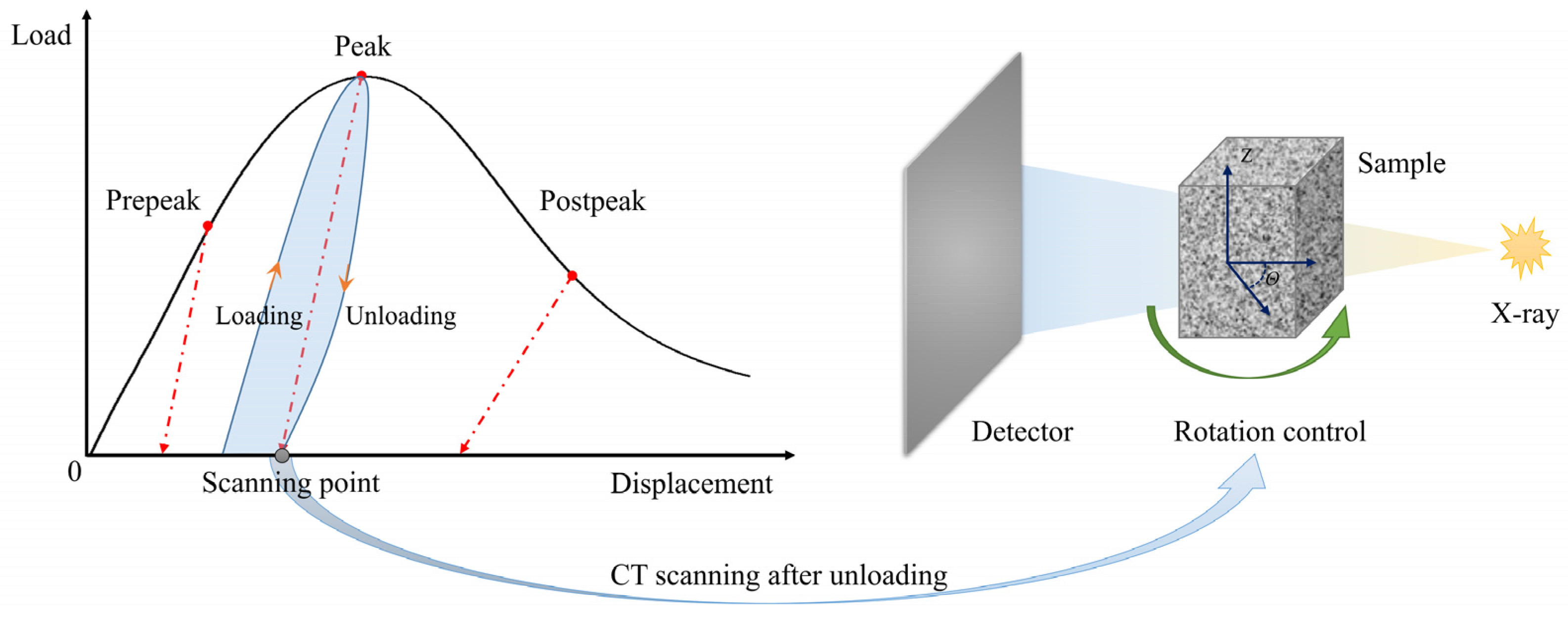
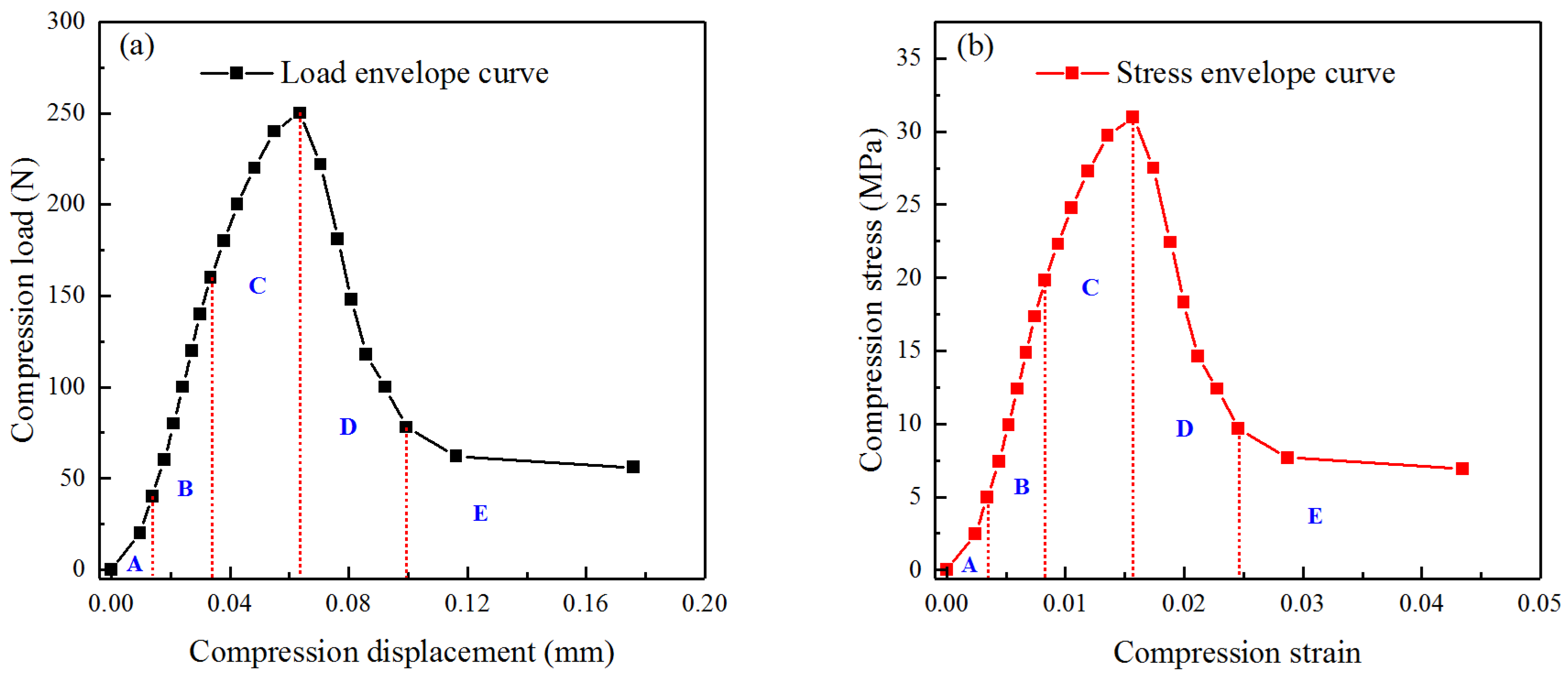

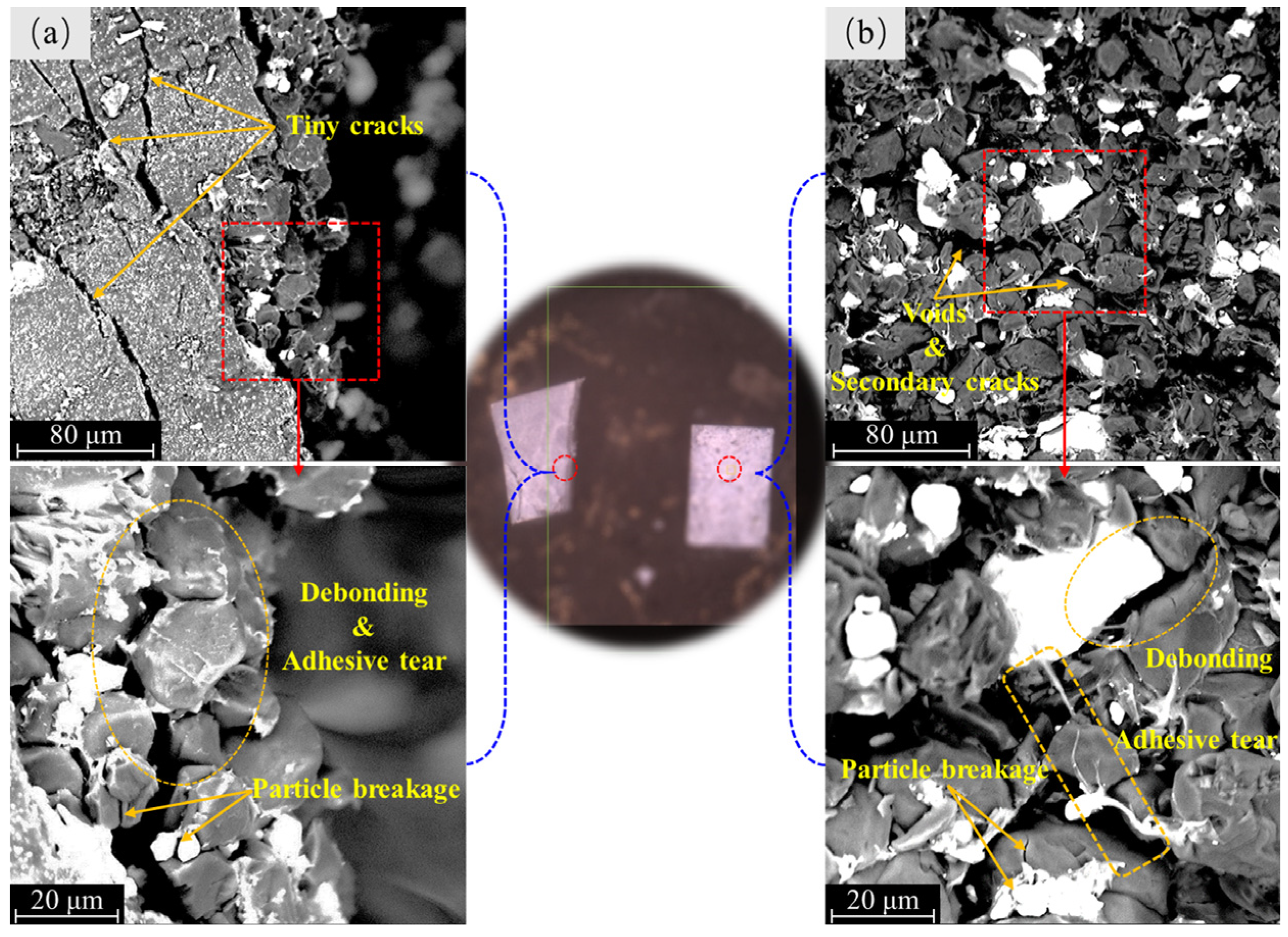


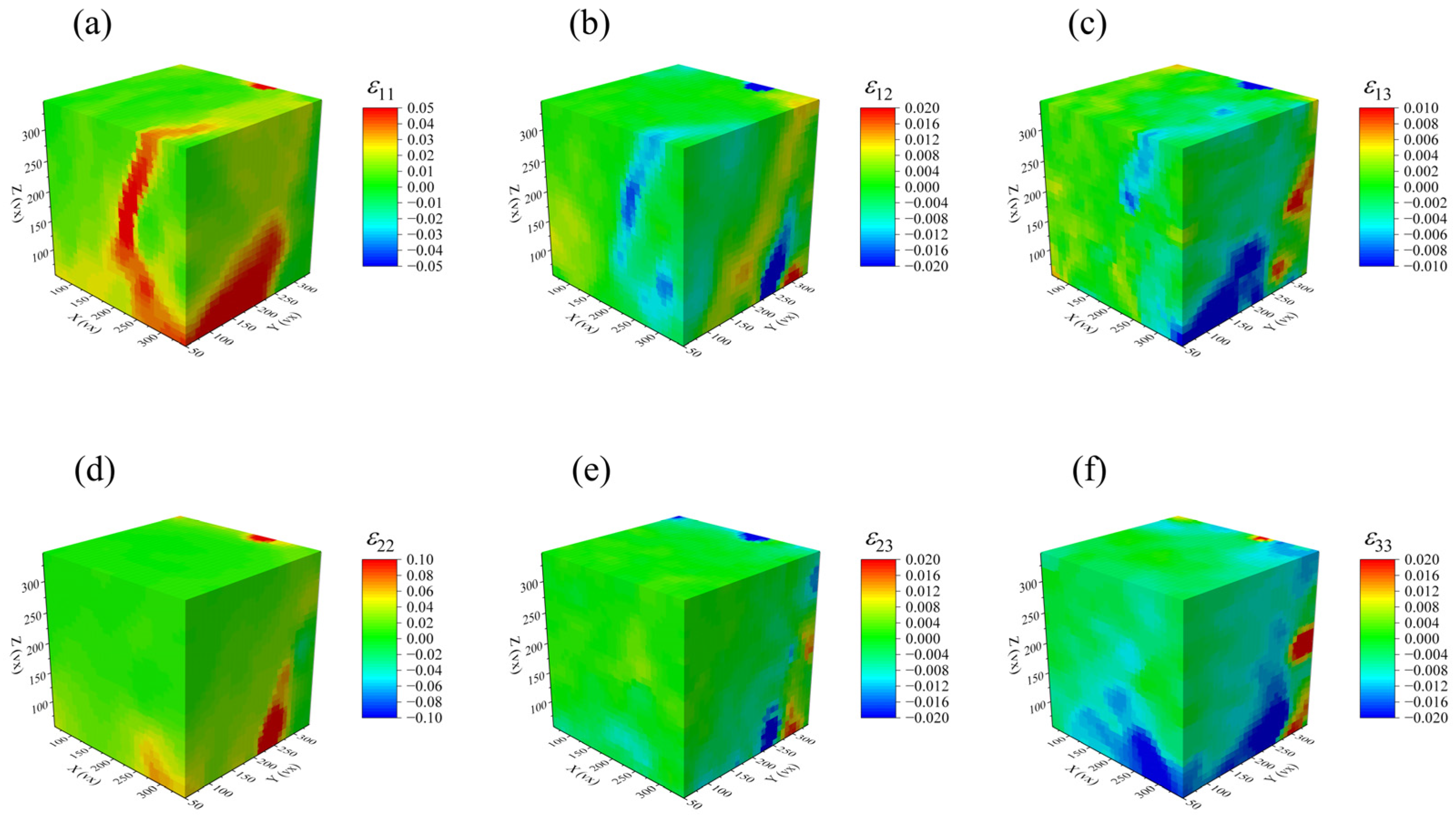

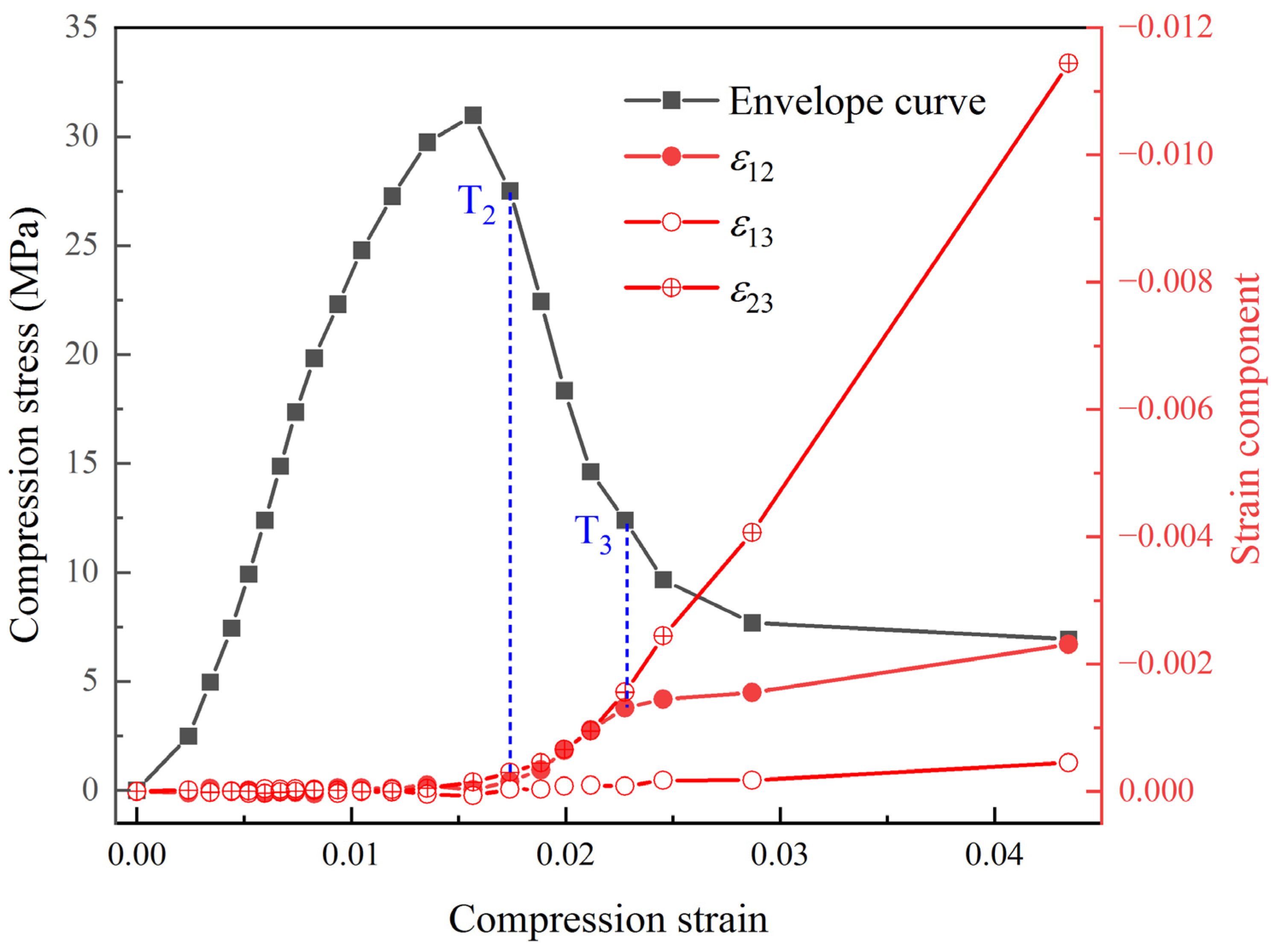



Disclaimer/Publisher’s Note: The statements, opinions and data contained in all publications are solely those of the individual author(s) and contributor(s) and not of MDPI and/or the editor(s). MDPI and/or the editor(s) disclaim responsibility for any injury to people or property resulting from any ideas, methods, instructions or products referred to in the content. |
© 2024 by the authors. Licensee MDPI, Basel, Switzerland. This article is an open access article distributed under the terms and conditions of the Creative Commons Attribution (CC BY) license (https://creativecommons.org/licenses/by/4.0/).
Share and Cite
Jia, D.; Hao, Z.; Peng, Y.; Yan, S.; Hu, W. Experimental Study on the Localized Deformation and Damage Behavior of Polymer-Bonded Explosive Simulant under Cyclic Compression. Materials 2024, 17, 919. https://doi.org/10.3390/ma17040919
Jia D, Hao Z, Peng Y, Yan S, Hu W. Experimental Study on the Localized Deformation and Damage Behavior of Polymer-Bonded Explosive Simulant under Cyclic Compression. Materials. 2024; 17(4):919. https://doi.org/10.3390/ma17040919
Chicago/Turabian StyleJia, Dong, Zhiming Hao, Yunqiang Peng, Shunping Yan, and Wenjun Hu. 2024. "Experimental Study on the Localized Deformation and Damage Behavior of Polymer-Bonded Explosive Simulant under Cyclic Compression" Materials 17, no. 4: 919. https://doi.org/10.3390/ma17040919
APA StyleJia, D., Hao, Z., Peng, Y., Yan, S., & Hu, W. (2024). Experimental Study on the Localized Deformation and Damage Behavior of Polymer-Bonded Explosive Simulant under Cyclic Compression. Materials, 17(4), 919. https://doi.org/10.3390/ma17040919




